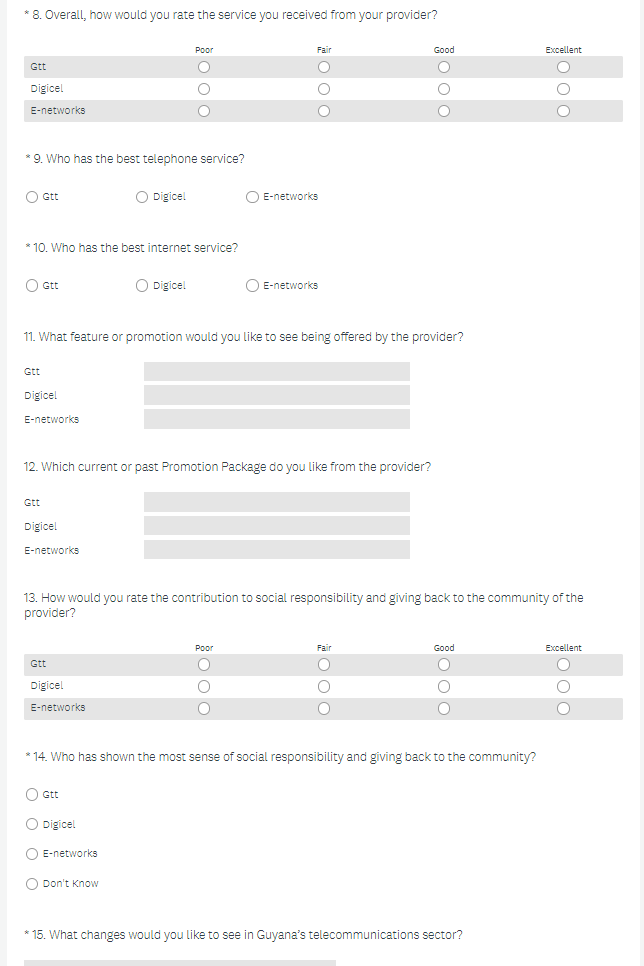
Public Perception of Telecommunication Services and the Effects of Telecom Liberalization in Guyana
| By Khari George |
Introduction
The Guyana Telecommunications sector has recently been liberalized. Given this development Customers may expect a more competitive market, better deals and promotional offers from service providers. The market was previously controlled by a monopoly shareholder known as Gtt. Gtt, has been in existence since the year 1990 and has undergone several rebranding initiatives. They have managed to secure themselves in the Guyanese market as one of its lead providers of telecommunication services ranging from phone calls, internet, software apps and electronic devices. In the year 2020, its monopoly grip on the market was released and now allows for more competitive practices in the industry.
The major competitors of Gtt, are Digicel and E-netowrks. Digicel is an international telecommunications network that operates in the Caribbean, Central America and Oceania regions. Its mobile network spans many countries and at one point for its operation in Guyana, had to rely on the use of Gtt’s infrastructure. It is currently in fierce competition with Gtt, for market share. Digicel´s range of services include mobile calls, internet and software applications. The other industry shareholder is E-networks. E-networks provide internet and cable television services and can be seen as a fast growing contender. E-networks has unrolled 5G internet services, extending its reach to customers through various LTE towers around the country.
Given these developments customer expectation may be heightened and curiosities peaked about what can be gained. While now operating in an open market, each operator needs to ensure customer satisfaction. According to Menon, S. customer satisfaction is the primary aim of every organization and its level is measured as a function of the difference of perceived performance and what is expected by customers. Menon, S. further states that customer perception is how a customer feels about the products and or services offered by a company. What does this mean to companies such as the three before mentioned? How are they perceived by their customer base, both current and potential? How can they leverage customer satisfaction to retain sales, gain revenue and generate new leads? It is said by Morgan, S. and Govender, K., that, a principal consideration for a business should be customer loyalty, as it is easier to generate repeat business from an existing customer than to obtain new customers. Yet more interestingly, it can be questioned what are the effects of the liberalization and what are the changes that customers hope to see in the near and far future? Providing answers to these questions can help businesses in the projection of their future revenues.
Objectives
To determine which service provider is perceived to have the best customer service and overall service within the telecoms sector in Guyana.
To determine what changes and more so the major ones that the public expect to see in the telecom sector in Guyana.
To determine the correlation between demographic and social aspects and a customers’ perception of telephone and internet services in Guyana.
Literature Review
According to Dr. Xavier, P. telecommunications regulation has placed emphasis on supply within the market, market entry, licensing and access to the services. It is highlighted that such focus is correctly allocated, as the task at hand was foster an effective mechanism of competitors in what was previously labelled as monopoly telecommunication markets. Having accomplished the aforementioned, the market has grown and new entrants have evolved. This has necessitated the adoption of principles that cater for the consumer demand-side. Which has been adopted in many OECD countries, an example of which may be the policy on the “portability of numbers” focused on enabling consumer switching in the fixed line and mobile markets. Such emphasis stimulates innovation, competitive pricing and marketing principles that serves the customers. The report sets out to address aspects of customer satisfaction and how it contributes to switching.
Zhu, X. and Venkatram, R. states that telecommunications sector is a cross industry enabler and driver of growth, as evidenced by developing nations based on its actual impact on their economies. The paper seeks to identify the influential factors within the telecom industry. Topics touched on includes the competitiveness between multinational companies and startups, the factors affecting growth of the telecom sector and the existing state with reference to liberalization, performance and regulatory and policy mechanisms.
Gurusamy, P. researched the level of satisfaction among customers of BSNL in Bhanvia Town. BSNL is a pioneer in the telecom sector within its zone of operations. Gurusammy states that it is very essential for a service provider to be in touch with the demographic factors that influence customer perception and their ability to feel that their expectations are being met.
Dr. Menon, S. states that customer satisfaction is the primary aim of every organization and its level is measured as a function of the difference of perceived performance and what is expected by customers. Menon, S. further states that customer perception is how a customer feels about the products and or services offered by a company. Factors identified for perception were tangibility, reliability, assurance, superior service, quality and empathy amongst others. Definitions of customer satisfaction and dissatisfactions are proffered and how each can be attained. According to Morgan, S. and Govender, K. a principal consideration for a business should be customer loyalty, as it is easier to generate repeat business from an existing customer than to obtain new customers. The research speaks to the competitive nature of the South African Telecoms sector and the customer centric focus of the industry to acquire and retain customers. It highlights the effect of brand image and the perceived value and how that affects the customers’ satisfaction. The research findings recommends that customer satisfaction should be center to attracting a cadre of loyal customers.

References
Dr. Xavier, P. (2007). Enhancing Competition in Telecommunications: protecting and empowering consumers. Organisation for Economic Co-operation and Development (OECD), Directorate for Science, Technology and Industry Committee for Information, Computer and Communications Policy. From http://www.oecd.org/digital/consumer/40679279.pdf.
Zhu, X. and Venkatram, R. (June, 2012). An analysis of Factors Influencing the Telecommunication Industry Growth. A case study of China and India. School of Management, Blekinge Institute of Technology. From https://www.diva-portal.org/smash/get/diva2:829355/FULLTEXT01.pdf
Gurusamy, P. (May, 2018). Customer Perception Towards Mobile Services – A Case Study of BSNL in Bhaviani Town. International Journal of Engineering and Technology 2 (4). From https://www.researchgate.net/publication/324942881_CUSTOMER_PERCEPTION_TOWARDS_MOBILE_SERVICES-A_CASE_STUDY_OF_BSNL_IN_BHAVANI_TOWN.
Dr. Menon, S. (March, 2014). Customer Perception Towards a Public Sector Telecom Company (BSNL) in Mobile Services. International Journal of Management and Social Sciences Research. Volume 3, No.3. From https://citeseerx.ist.psu.edu/viewdoc/download?doi=10.1.1.428.8067&rep=rep1&type=pdf. Morgan, S. and Govender, K. (2017). Exploring Customer Loyalty in the South African Mobile Telecommunications Sector. Cogent Business and Management ISSN 2331-1975, Taylor & Francis, Abingdon, Vol 4. From http://dx.doi.org/10.1080/23311975.2016.1273816